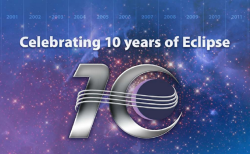10 years of Eclipse: Consolidating the Java IDE market
Ten years ago, IBM first presented the Eclipse development environment to a global audience as open source software. Wherever such figures may originate from: the estimated $40 million that the donated code including marketing efforts was said to be worth at the time in 2001 have turned into more than $800 million today, estimates Eclipse Foundation Executive Director Mike Milinkovich; the Eclipse Foundation was founded in 2004.
However, a more tangible fact is that Eclipse has considerably stirred up the market for Java development environments, causing such former top dogs as JBuilder, OptimalJ, Rational Application Developer, WebGain and JDeveloper to disappear or play a niche role. In Germany, for example, Eclipse has steadily held a market share of more than 70 per cent over the past few years. The Eclipse Foundation estimates that there are 6 million Eclipse developers worldwide. Only IntelliJ IDEA and NetBeans enjoy a comparative level of popularity.
Detachment
However, it is not only IBM's developer teams in Zurich and Ottawa who are responsible for the success of Eclipse – the core developers already came on board when Object Technology International (OTI) was taken over in 1996. The development environment and its eco system only gathered serious momentum after a dedicated foundation was formed. By detaching Eclipse from IBM in early 2004, the Foundation's founding members (including IBM) hoped to spread the influence of Eclipse's technologies, as they thought that an independent organisation would make it easier for other software companies to participate in the success of the Eclipse eco system.
Their plan worked, among other things because of the reorientation of Eclipse 3.0 that took place when the modular OSGi architecture was implemented in summer 2004. When the open source organisation celebrated a decade of Eclipse with more than 500 EclipseCon Europe 2011 participants in Ludwigsburg, Germany last week, it counted more than 170 member companies and over 1,000 committers that are involved in about 270 Eclipse projects. However, not all of these projects are to do with Java development, and projects such as the Eclipse C/C++ Development Tools (CDT) are extremely successful in the area of embedded and real-time operating systems. Especially in model-driven software development, tool developers are giving preference to the range of Eclipse technologies that is almost ubiquitous in this sector. A similar situation appears to be developing in the Application Lifecycle Management (ALM) area, where Eclipse Mylyn with its more than 80 connectors has become a central integration hub.
Cycles
The decision to publish annual "Eclipse Release Trains" from 2006 has also proven successful. For this annual release of a new Eclipse version in late June each year, participating Eclipse projects commit to complying with the necessary quality requirements. While "Callisto" in 2006 involved 10 Eclipse projects, more than 60 projects crossed the finishing line for the "Indigo" release in June 2011; the Eclipse Foundation said that they generated about 46 million lines of code in total.
A new area is covered by the Eclipse Foundation's Industry Working Groups, which the organisation has created to introduce Eclipse technologies into vertical markets. In addition to the less successful work in the area of mobile development, new working groups have been established for the automotive industry, for M2M communication, and for embedded and safety-critical systems. The coming decade will tell how successful their efforts to promote the popularity of Eclipse will be in these sectors.
(crve)

![Kernel Log: Coming in 3.10 (Part 3) [--] Infrastructure](/imgs/43/1/0/4/2/6/7/2/comingin310_4_kicker-4977194bfb0de0d7.png)

![Kernel Log: Coming in 3.10 (Part 3) [--] Infrastructure](/imgs/43/1/0/4/2/3/2/3/comingin310_3_kicker-151cd7b9e9660f05.png)
















